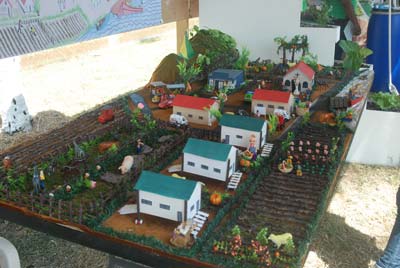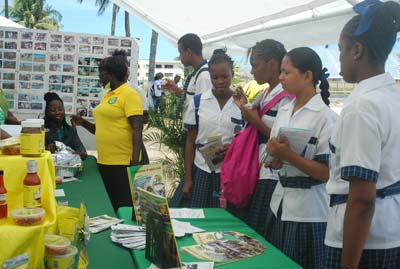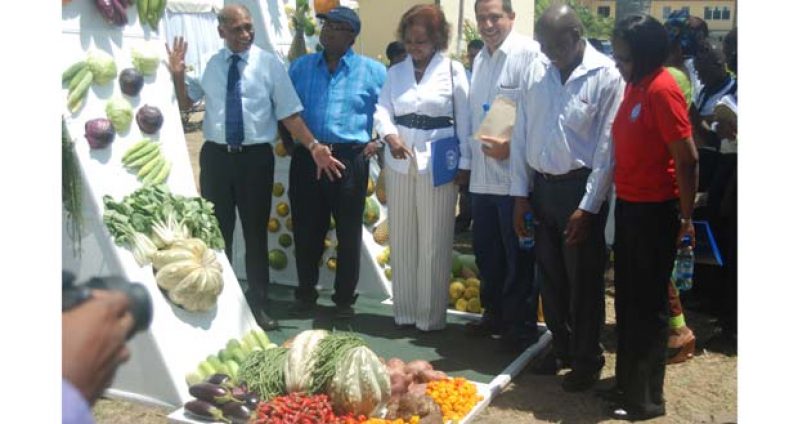GUYANA marked World Food Day 2014, being held under the theme ‘Feeding the world, caring for the earth’, with the official launch of its ‘Eat What We Produce’ campaign on Wednesday.

The aim of the campaign to promote a permanent behavioural change in Guyana, which will see Guyanese only eating what is produced locally and to expand the country’s unique Guyanese hospitality to include feeding guests what is grown and produced in Guyana.
“Brand Guyana must be something that we appreciate,” said Agriculture Minister Dr. Leslie Ramsammy to a gathering that included representatives from the diplomatic corps, Member of Parliament (MP) Manzoor Nadir, and ministry staffers.
NUTRITION SECURITY

On that note, he stressed that while Guyana, like some countries, is food secure, there must be a stronger focus on nutrition security.
“When last did your plate (of food) look like a rainbow?” the Minister queried, adding that this is an indication of a balanced meal.
He highlighted the importance of family farms in providing quality produce that assist in ensuring nutrition security, another reason to ‘go local’.
“We have to go local….local produce is safe, high quality and nutritious,” the Minster said yesterday at the National Research and Extension Institute (NAREI).
According to him, continued investments in this area will continue to be made. “Agriculture must be supported by investment for the public good,” he said.
Dr. Ramsammy stated too that decades ago the investment was a mere US$5 per capita, whereas under the current

Administration it has increased to US$100 per capita in 2014.
Investments, he stressed, will not only ensure nutrition security and sustain food security, but will also contribute to the creation of employment opportunities, generate wealth and contribute to the local economy, via an increase in food exports.
AGRICULTURE ECONOMY
The Agriculture Minister was emphatic in stressing that Guyana is an “agriculture country” when one considers that almost 20 per cent of the economy is related to agricultural activities.
Currently, he stated, there is a huge focus on a value chain in the sector. “We must support agricultural moves in the area of value chains, which will generate wealth, employment and ensure there are greater moves from subsistence farming,” he said.
Dr. Ramsammy pointed out that in the past the focus was mainly on primary products.
“Family farming has sustained agriculture,” he said, reiterating the importance of family farms.
Dr. Ramsammy added too that going forward agriculture not only drives the economy, but also assists in sustaining economic growth and informs the country’s development trajectory.
As part of Government’s ongoing efforts to sustain the gains made towards the diversification of the sector, a total of $829.4M was expended in the agriculture sector in the first half of the year, from a budget allocation of $1.5B.
The Minister maintains that these initiatives will serve to reduce vulnerabilities and enhance the standard of living for Guyanese.
Inter-American Institute for Cooperation on Agriculture (IICA) representative, Mr. Wilmot Garnett, in a brief address added that continued investments are imperative.
He stated that as it relates to family farming, this area contributes to increased food production, preservation of traditional food staples and income generation – all of which support rural prosperity.
According to him, there needs to be greater focus on increasing production, improving competitiveness and farming systems in order to move the sector to an age of greater innovation.
Garnett acknowledged that there are challenges, but maintained that innovations in the sector will address these to support the sustainability of the sector.
Also making remarks, at yesterday’s launch, was the Food and Agricultural Organisation representative, Ms. Khadija Musa, who read an address from the FAO Director-General, José Graziano da Silva.
Both FAO and IICA are constant supporters of the advances in the local agriculture sector.
OPEN DAY
Additionally, yesterday’s event doubled as NAREI’s open day activity which saw scores of students from schools, including nursery, touring the facility and viewing an exhibition put on by the Institute, as well as a special display of local Guyanese products.
NAREI CEO, Dr. Oudho Homenauth, stated that the exhibits are showcasing the initiatives undertaken by the Institute, regarding cassava production, plantain production, urban agriculture, spice production, climate smart agriculture and pest and disease control.
NAREI is the premier organisation responsible for spearheading agricultural research and extension activities for productivity enhancement and diversification of the non-traditional crops sector (fruits and vegetables), bio-fuel development as well as for plant quarantine services.
NAREI’s vision is “to ensure food security, prosperity and livelihoods of all, using technological innovations in agriculture.”
The Institute is actively engaged in adaptive research that focuses on improving crop production/ productivity for enhanced food security and rural development. Emphasis is placed on crop diversification from high volume-low income to low volume-high income crops such as spices and other cash crops, new vegetables (cauliflower, broccoli, red cabbage and sweet pepper), IPM approach to managing biotic stresses, procurement and evaluation of exotic germplasm (black eye, corn and soybean) of field crops, bio fuel crops, coconut and cassava revitalisation, and technology dissemination through the extension services.
The promotion of Climate Smart Agricultural Practices inclusive of protected agricultural systems for year-round vegetable production, hydroponics and drip irrigation is also given prominence.
NAREI’s Strategic Plan (2013- 2020) envisions the Institute as being the major facilitator for a prosperous, food secure and environmentally sustainable Guyana. This will be achieved through enhancing agricultural productivity and quality of produce through generation and dissemination of newer and efficient technologies and services reduced import of agri produce and products, reduced malnutrition and environmental degradation and enhanced exports taking into consideration the changing global and business environments.
(By Vanessa Narine)



.jpg)








